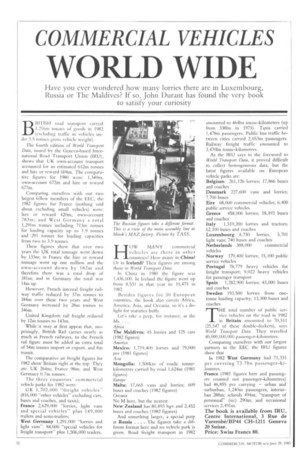COMMERCIAL VEHICLES
Page 34

If you've noticed an error in this article please click here to report it so we can fix it.
WORLD WIDE
Have you ever wondered how many lorries there are in Luxembourg, Russia or The Maldives? If so, John Durant has found the very book to satisfy your curiosity
BRITISH road transport carried 1,216m tonnes of goods in 1982 (excluding traffic in vehicles under 3.5 tonnes gross vehicle weight).
The fourth edition of World Transport Data, issued by the Geneva-based International Road Transport Union (IRU), shows that UK own-account transport accounted for an estimated 612m tonnes and hire or reward 604m. The comparative figures for 1980 were: 1,349m, own-account 672m and hire or reward 677m.
Comparing ourselves with our two largest fellow members of the EEC, the 1982 figures for France (nothing said about excluding small vehicles) were: hire or reward 420m, own-account 783m; and West Germany a total 1,291m tonnes including 713m tonnes for loading capacity up to 1.9 tonnes and 291 tonnes for loading capacities from two to 3.9 tonnes.
These figures show that over two years the UK total tonnage went down by 133m; in France the hire or reward tonnage went up one million and the own-account down by 182tri and therefore there was a total drop of 181m; and in Germany the total was 14in up.
However, French internal freight railway traffic reduced by 37m tonnes to 184m over these two years and West Germany increased by 28m tonnes to 346ni.
United Kingdom rail freight reduced by 12m tonnes to 143m. . While it may at first appear that, surprisingly, British Rail carries nearly as much as French railways, to the French rail figure must be added an extra total of 54m tonnes import or export, and 8m transit.
The comparative air freight figures for 1982 show Britain right at the top. They are: UK 264m; France 98m; and West Germany 0.7m tonnes.
The three countries' commercial vehicle parks for 1982 were: UK 1,702,000 "freight vehicles" (816,000 "other vehicles" excluding cars, buses and coaches, and taxis);
France 2,629,000 "lorries, light vans and special vehicles" plus 149,000 trailers and semi-trailers; West Germany 1,291,000 "lorries and light vans", 84,000 "special vehicles for freight transport" plus 1,506,000 trailers. F/OW MANY commercial vehicles are there in other countries? How many in China? Or in Iceland? Their figures are among those in World Transport Data.
In China in 1980 the figure was 1,436,000. In Iceland the figure went up from 8,531 in that year to 10,475 in 1982.
Besides figures for 30 European countries, the book also covers Africa, America, Asia, and Oceania, so it's a delight for statistics buffs.
Let's take a peep, for instance, at the Ms. . .
Africa
The Maldives: 45 lorries and 125 cars
(1982 figures) America
Mexico: 1,719,400 lorries and 79,000
psv (1981 figures) Asia
Mongolia: 1,500km of roads; tonne
kilometres carried by road 1,624m (1981 figures) Europe
Malta: 17,665 vans and lorries; 609
buses and coaches (1982 figures) Oceania No M here, but the nearest
New Zealand has 80,893 hgv and 2,452
buses and coaches (1982 figures) And something larger, a special peep
at Russia .... The figures take a dif
ferent format here and no vehicle park is given. Road freight transport in 1982 amounted to 464bn tonne-kilometres (up from 338bn in 1975). Taxis carried 1,478in passengers. Public bus traffic between cities carried 2,053m passengers. Railway freight traffic amounted to 3,470bn tonne-kilometres.
As the IRU says in the foreword to World Transport Data, it proved difficult to collect homogeneous data, but the latest figures available on European vehicle parks are: Belgium 261,126 lorries; 17,866 buses and coaches Denmark 227,600 vans and lorries; 7,700 buses Eire 68,000 commercial vehicles; 6,400 public service vehicles Greece 458,006 lorries; 18,493 buses and coaches Italy 1,519,200 lorries and tractors; 62,100 buses and coaches Luxembourg 4,730 lorries, 5,701 light vans; 740 buses and coaches Netherlands 388,000 commercial vehicles Norway 179,400 lorries; 15,100 public service vehicles Portugal 78,779 heavy vehicles for freight transport; 9,022 heavy vehicles for passenger transport Spain 1,282,900 lorries; 43,000 buses and coaches Sweden 193,500 lorries from onetonne loading capacity; 13,300 buses and coaches THE total number of public service vehicles on the road in 1982 in Britain amounted to 70,511 (25,547 of these double-deckers), says World Transport Data. They travelled 40,000,000,000 passenger-kilometres. Comparing ourselves with our largest partners in the EEC the IRU figures show that In 1982 West Germany had 71,331 psv covering 73.7bn passenger-kilonutes; France (1981 figures here and passengers counted not passenger-kilometres) had 46,855 psv carrying urban and surburban, 1,240m passengers; interurban 288m; schools 494m; "transport of personnal" (sic) 290m; and occasional services 2,491m.
The book is available from IRLT, Centre International, 3 Rue de Varembe/BP44 CH-1211 Geneva 20 Suisse.
Price: Swiss Francs 80.




































































































